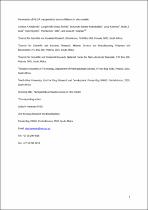JavaScript is disabled for your browser. Some features of this site may not work without it.
- ResearchSpace
- →
- Research Publications/Outputs
- →
- Journal Articles
- →
- View Item
| dc.contributor.author |
Nkabinde, LA

|
|
| dc.contributor.author |
Shoba-Zikhali, LN

|
|
| dc.contributor.author |
Semete-Makokotlela, Boitumelo

|
|
| dc.contributor.author |
Kalombo, Lonji

|
|
| dc.contributor.author |
Swai, HS

|
|
| dc.contributor.author |
Hayeshi, R

|
|
| dc.contributor.author |
Naicker, B

|
|
| dc.contributor.author |
Hillie, TK

|
|
| dc.contributor.author |
Hamman, JH

|
|
| dc.date.accessioned | 2013-02-19T10:12:29Z | |
| dc.date.available | 2013-02-19T10:12:29Z | |
| dc.date.issued | 2012-07 | |
| dc.identifier.citation | Nkabinde, LA, Shoba-Zikhali, LN, Semete-Makokotlela, B, Kalombo, L, Swai, HS, Hayeshi, R, Naicker, B, Hillie, TK and Hamman, JH. 2012. Permeation of PLGA nanoparticles across different in vitro models. Current Drug Delivery, vol. 9(6), pp 617-627 | en_US |
| dc.identifier.issn | 1567-2018 | |
| dc.identifier.uri | http://lib.bioinfo.pl/paper:22812395 | |
| dc.identifier.uri | http://hdl.handle.net/10204/6563 | |
| dc.description | Copyright: 2012 Bentham Science Publishers. This the Pre/post print version of the work. The definitive version is published in Current Drug Delivery, vol. 9(6), pp 617-627. | en_US |
| dc.description.abstract | Many drug delivery systems have indicated improvement in delivery of various drug molecules and among these biodegradable and biocompatible polymers such as poly(D,L-lactide-co-glycolide) (PLGA) have been shown to enhance intracellular uptake of drug candidates when formulated as nanoparticles. PLGA nanoparticles were prepared by means of a double emulsion solvent evaporation technique and evaluated in terms of size, encapsulation efficiency, surface charge, isoniazid release and in vitro transport. The nanoparticles have an average size of 237 nm and were previously shown to be distributed in several tissues after oral administration without triggering an immune response. This study focussed on the in vitro permeation of the PLGA nanoparticles across different membranes and showed that although Rhodamine 6G-labelled nanoparticles are efficiently delivered across the intestinal epithelium, its epithelial permeability changes when a drug such as isoniazid is encapsulated. Future studies should focus on ways to optimise PLGA nanoparticle delivery when a drug such as isoniazid is encapsulated for instance by coating with polymers such as polyethylene glycol. | en_US |
| dc.language.iso | en | en_US |
| dc.publisher | Bentham Science Publishers | en_US |
| dc.relation.ispartofseries | Workflow;10014 | |
| dc.subject | Drug molecules | en_US |
| dc.subject | Polymers | en_US |
| dc.subject | Nanoparticles | en_US |
| dc.subject | Pharmaceutical industry | en_US |
| dc.title | Permeation of PLGA nanoparticles across different in vitro models | en_US |
| dc.type | Article | en_US |
| dc.identifier.apacitation | Nkabinde, L., Shoba-Zikhali, L., Semete-Makokotlela, B., Kalombo, L., Swai, H., Hayeshi, R., ... Hamman, J. (2012). Permeation of PLGA nanoparticles across different in vitro models. http://hdl.handle.net/10204/6563 | en_ZA |
| dc.identifier.chicagocitation | Nkabinde, LA, LN Shoba-Zikhali, Boitumelo Semete-Makokotlela, Lonji Kalombo, HS Swai, R Hayeshi, B Naicker, TK Hillie, and JH Hamman "Permeation of PLGA nanoparticles across different in vitro models." (2012) http://hdl.handle.net/10204/6563 | en_ZA |
| dc.identifier.vancouvercitation | Nkabinde L, Shoba-Zikhali L, Semete-Makokotlela B, Kalombo L, Swai H, Hayeshi R, et al. Permeation of PLGA nanoparticles across different in vitro models. 2012; http://hdl.handle.net/10204/6563. | en_ZA |
| dc.identifier.ris | TY - Article AU - Nkabinde, LA AU - Shoba-Zikhali, LN AU - Semete-Makokotlela, Boitumelo AU - Kalombo, Lonji AU - Swai, HS AU - Hayeshi, R AU - Naicker, B AU - Hillie, TK AU - Hamman, JH AB - Many drug delivery systems have indicated improvement in delivery of various drug molecules and among these biodegradable and biocompatible polymers such as poly(D,L-lactide-co-glycolide) (PLGA) have been shown to enhance intracellular uptake of drug candidates when formulated as nanoparticles. PLGA nanoparticles were prepared by means of a double emulsion solvent evaporation technique and evaluated in terms of size, encapsulation efficiency, surface charge, isoniazid release and in vitro transport. The nanoparticles have an average size of 237 nm and were previously shown to be distributed in several tissues after oral administration without triggering an immune response. This study focussed on the in vitro permeation of the PLGA nanoparticles across different membranes and showed that although Rhodamine 6G-labelled nanoparticles are efficiently delivered across the intestinal epithelium, its epithelial permeability changes when a drug such as isoniazid is encapsulated. Future studies should focus on ways to optimise PLGA nanoparticle delivery when a drug such as isoniazid is encapsulated for instance by coating with polymers such as polyethylene glycol. DA - 2012-07 DB - ResearchSpace DP - CSIR KW - Drug molecules KW - Polymers KW - Nanoparticles KW - Pharmaceutical industry LK - https://researchspace.csir.co.za PY - 2012 SM - 1567-2018 T1 - Permeation of PLGA nanoparticles across different in vitro models TI - Permeation of PLGA nanoparticles across different in vitro models UR - http://hdl.handle.net/10204/6563 ER - | en_ZA |






